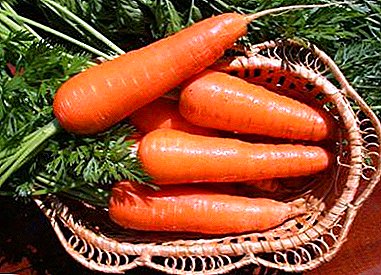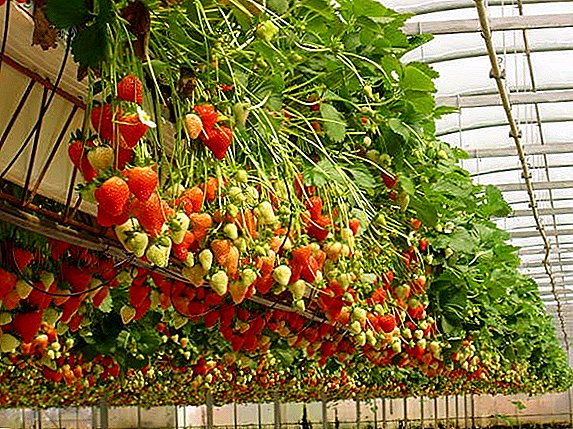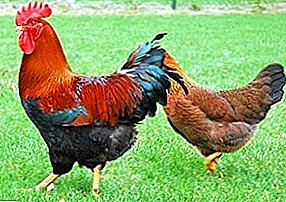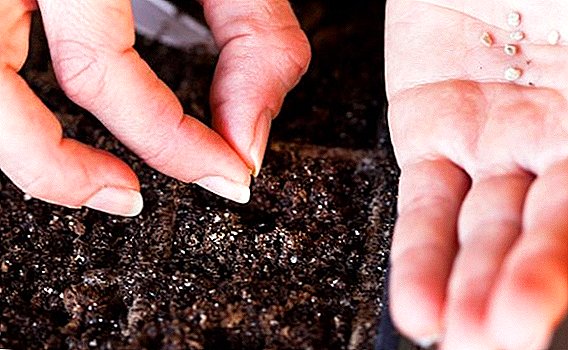
Important quality indicators of carrots are high sugar content, large size and even shape.
In order to grow a sugary, large and crunchy carrot, a sunny plot is prepared in advance, and potash and phosphate fertilizers are introduced in the fall. They dig up deeply, plant siderats, sometimes pour them into beds of sand.
After sowing, pay attention to the correctness of irrigation and fertilizing. It is also important to choose the right grade. About this and much more - in the article.
The list of factors in cultivation that affect the quality of the root
The causes of small, savory and tasteless carrots:
- Heavy stony or clay earth.
- Sour pH below 5.5.
- Wrong selection of varieties - instead of F1, sowing carrots F2 with signs of wild root.
- Lack of watering at the beginning of the season.
- Shallow arable layer.
- Deficiency of important mineral components, especially potassium.
- Making an excess of fresh organics.
- Damage to carrot fly landings.
- Late harvesting.
When choosing a grade, pay attention to keeping quality. Carrots for long-term storage are inferior to taste varieties for quick consumption.
The main cause of low sugar content is a deficiency of potassium and phosphorus. Phosphoric salts increase the level of sugars, potassium affects the growth of tissues and the formation of tender pulp. The sweetness of a vegetable on acidified lands is sharply reduced.
To neutralize:
- 1 time in 6-8 years lime a site.
- Wood ash is added when digging 0.5-1.2 kg per 1 m2.
Attention! Late harvest at the root deteriorates the taste and the vegetable can taste bitter.
Why can a carrot in the garden be small?
 Carrot loves moderately moist, well loosened and light soil with sufficient oxygen access to the root system. In compacted or heavy black soil, the size of the root is much smaller. Vegetable demanding moisture at the beginning of the growing season.
Carrot loves moderately moist, well loosened and light soil with sufficient oxygen access to the root system. In compacted or heavy black soil, the size of the root is much smaller. Vegetable demanding moisture at the beginning of the growing season.
Especially adversely affect growth:
- Fertilizer beds manure.
- Untreated heavy soil.
- Superficial crust after irrigation or rain.
- Uneven watering.
- Drying the ground.
Step-by-step instruction: how to make it big, sweet and juicy?
Consider what needs to be done to the carrot in the garden grew large, and was also sweet and juicy. To obtain a quality crop, you should follow the agrotechnical rules..
The right choice of place and predecessors
Carrots need a lot of sun to build an above-ground part and a root crop. High crops - corn, sunflower as neighbors are planted only on the north side in order to avoid shading.
Carrot grows superbly after such predecessors:
- Cucumbers.
- Beans.
- Squashes.
- Potatoes.
- Bow.
- Lentils
- Pumpkin.
- Tomatoes.
reference! If no garden crops are sown on the beds, carrots are returned to the same bed after 3-4 years.
Optimum time of sowing in an open ground
Terms depend on the region, climate, weather conditions. A sweeter carrot, which is sown in the fall, as well as early varieties for spring planting.
| Types of landings | Timing |
| Sub-winter sowing | Mid-end of November, the Earth should freeze slightly |
| Sowing early varieties | The second half of April In the soil a lot of moisture after snow melt |
| Crops of mid-season varieties | The end of April, the beginning of May. The earth is warm and slightly dried. |
| Planting late-ripening species | The end of May, the first 2 decades of June |
Special soil preparation
 Carrots are demanding for soil looseness. Ideal for her:
Carrots are demanding for soil looseness. Ideal for her:
- Sandwiches
- Loam
- Peatlands.
Increased ground density is easy to fix.:
- To do this, make a spring of 1 m2 of 1 bucket of sand.
- They carry out deep digging on the spade bayonet, loosen it with a rake.
The softer and more fluffy the ground becomes, the larger the roots grow.
Sand can be scattered between the rows, driving into the soil when loosening.
You can sow carrots in the beds-boxes. To do this, they are filled with loose soil mixture:
- Turf.
- Sand.
- Dead compost
- Peat.
Improving the quality of the soil and the taste of carrots helps sideratov planting:
- Mustard.
- Oats
- Phacelia
Mulching with a thick layer up to 10 cm has a good effect on enlargement
Good care
From compliance with the rules of agricultural technology largely depends on the marketability of the vegetable and taste characteristics:
On the hard lands they carry out a well landing:
- Crusher make grooves up to 40 cm.
- Humus-ash substrate fall asleep.
- Bring seeds of 1-2 pieces and sprinkle.
Because of the invasions of carrot flies, the taste of vegetables becomes bitter, the growth of root crops slows down. To combat pests, tobacco dust is poured in between the rows. Carried out for the purpose of prevention when thinning seedlings.
Watering
In the first month after planting, water is plentiful, so that the soil is soaked to 15-20 cm in depth. The frequency of watering 2-3 times a week. Gradually in 40-45 days the multiplicity and volumes decrease.
Thinning
A growing seedling needs room to grow. Timely thinning improves stitchiness of root crops. The optimum distance is 3-5 cm. The first thinning is carried out in the presence of 1 true leaf.
Top dressing
 To make the carrot sweet, minerals are used for feeding.. When introducing organic matter - manure or compost, the above-ground stalks grow rapidly, and the root crops become shallow, tasteless, fibrous and coarse. Carrots go entirely to the tops, roots get iodine unpleasant taste.
To make the carrot sweet, minerals are used for feeding.. When introducing organic matter - manure or compost, the above-ground stalks grow rapidly, and the root crops become shallow, tasteless, fibrous and coarse. Carrots go entirely to the tops, roots get iodine unpleasant taste.
Organic dressing contribute to the beds with their predecessors - pumpkins, potatoes, zucchini.
The sugar content of carrots increases by 30-50%:
- Phosphorus potash mixture.
- Sodium HUMATE
- Magnesium supplements.
- Boric acid.
- Wood ash, as a source of potassium, boron, manganese.
reference. By using manganese sulphate in a ratio of 1 to 10 water, the content of sugars and carotene is increased.
Irrigated in august. If the carrot is not sweet, prepare a solution of boric acid for spraying the beds in the following ratio:
- 2 tbsp. boron.
- 4 l. water.
Foliar dressing is carried out from the second half of August. Several times carrots feed complex composition.
For fertilizer prepare a solution of the following components:
| Title | amount |
| Water | 10 l |
| Potassium nitrate | 20-25 g |
| Double superphosphate | 15 g |
| Urea | 15 g |
Apply for dressings 3 times per season:
- The first. In 10-14 days from the moment of emergence of shoots.
- Second and third. 2 weeks after the previous one.
Well increases the marketability of wood ash. Poured into the grooves in a dose of 100 g per 1 m2.
Proper harvesting
To harvest the root crops proceed in dry weather. It is undesirable to dig a crop after a rain; the carving may crack, burst. It becomes watery and loses sweetness.
Then you can watch a video that tells step by step how a gardener should act to grow sweet and large carrots:
List of varieties
The most popular varieties with bright orange color, sugar and crispy flesh, large sizes.
The sweetest
 Sweet tooth. Little core. The average weight is 80-100 g. Matures in late terms. Bonuses - deadliness, productivity, great taste.
Sweet tooth. Little core. The average weight is 80-100 g. Matures in late terms. Bonuses - deadliness, productivity, great taste.- Olympus. High levels of carotene and sugars. It grows in length up to 22 cm. The color is red-orange.
- Marmalade. Sugar hybrid with ripening in average terms. Weight 140-200 g. Long stored.
- Caramel. The flesh contains a lot of sugars. Ideal for children and diet, mashed potatoes and juices. Length within 15-20 cm.
- Amsterdam. Medium early variety. The pulp is sugary, juicy, crunchy. Weight 140-200 g. Length about 20 cm.
- Nastena Slastena. Maturation in 76-120 days. The core is small. Weight from 80 to 180 g
- Honey and sugar. High-yielding hybrid of medium early ripening. The form is cylindrical. With honey aroma and high level of sugars.
Large and long
- Chantenay Royal. It grows up to 18-20 cm in length. Weight varies within 0.2 kg. Ideal for storage.
- Baltimore. A hybrid of the Berlicum group. The mass of 1 vegetable reaches 250 g. It is high-yielding -120 t / ha.
- Jerada. Early hybrid. Return of the crop in 90 days. Weight 200-250 g, length 25 cm, diameter 5-6 cm.
- Abaco. Maturation after 110 days. The average size is 18-20 cm. Diameter 4-6 cm. Does not crack.
Nobody likes carrots with bitterness and small sizes. In order to grow beautiful root crops with excellent taste, they sow seeds in loosened soil with sand and peat, thin out, loosen inter-row spans. Feed up in several stages with mineral solutions with the obligatory content of potassium, phosphorus, and boron.


 Sweet tooth. Little core. The average weight is 80-100 g. Matures in late terms. Bonuses - deadliness, productivity, great taste.
Sweet tooth. Little core. The average weight is 80-100 g. Matures in late terms. Bonuses - deadliness, productivity, great taste.









